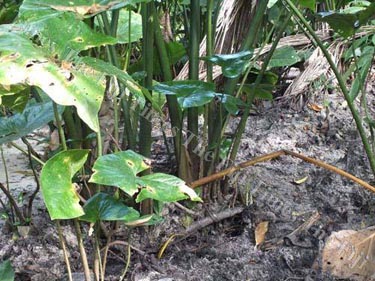|
|
||||
| From Fiji Times Online (22 March 2013) Strong swamp signals by Monifa Fiu
Existence of these notable areas on Rotuma used to be bordered away from settlement with planting of the women's pandanus patches (for their mats) along the coastal road. The stone fencing for the village pigs presses in on the swampland from the hill forests. The wetland is an important part of the island ecosystem providing habitat and food source to many living flora and fauna as part of the island biodiversity. Rano swampland is also culturally associated to certain customary practices and subsistence resource use in past coping strategies during times of natural disaster or extreme dry periods. This is one plant associated with past diet and subsistence economy in the Pacific. It maybe field stored in the ground for very long periods up to 30 years and has traditionally been an emergency crop in times of natural disaster and food scarcity. Very little is known of the biodiversity in these swamplands and how much of this resource remains, except that the practice of harvesting the tuberous swamp plant for certain feasts are becoming less frequent. These swamps or rano capture much of the surface water that recharges the island's freshwater lens, the water source for households. The islanders perceived that these rano swamplands are fast disappearing mainly from change in average weather over time, land use patterns (eg crop damage caused by feral pigs), increased mono-crop agriculture, shift in community's resource use caused by shift in resource value (eg the value of planting the tuberous plant), limited replanting of the Cyrtosperma chamissonis locally known as papai or via in most parts of Fiji. This prehistoric swamp crop can take years to grow and cultivar dependent where land needs to be tilled in order to raise the giant swamp taro. The via plant species is well adapted to moist tropical climates and does well in warm, seasonally moist climates that have a short dry season and variable precipitation. A main factor for its growth is a continuous supply of water, but it can tolerate short periods of dryness. It tolerates shade and mildly tolerant of saline growing conditions compared to other dalo species (FAO, 2010). Upon consideration, wouldn't the question posed be that the utilisation of the swamp crop is in decline due mainly to lack of practice to replant, once the crop was harvested or damage caused by feral pigs. Preliminary results of habitat change detection mapping of the rano swampland over a time series, by using satellite imagery (2007, 2010) and aerial photographs (1982) suggested these notable areas have increased. However, most recent land use and growth of the swamp crop labelled as via were smaller compared to earlier map profiles. Rotuma's equatorial location at 12 degree south of the equator, implies hotter uncomfortable conditions than currently experienced. Generations of accumulated traditional knowledge relating to seasonal variations in rainfall, temperature, winds and pollination, and their influence on crop planting and harvesting times now lie in jeopardy given the unparalleled speed of environmental change impacting us (http://agroforestry.net/scps). The extent to which similar set communities like Rotuma are vulnerable to climate change depends in part on the magnitude, rate of climate change and its consequent impacts but also on their adaptive capacity. This adaptive capacity is often limited by lack of resources, remoteness with restricted communication, access to information, transportation and poor institutions. Back in the island home, efforts are endorsed by the Council of Rotuma, led by the Rotuma Women Association to engage with rano communities in restorative actions and awareness on values of protecting these critical swamplands' potential risk of drying up and growth of the specialty crop within from disappearing. These activities are supported by the SPC/GIZ funded Rano project directed by LäjeRotuma that is aimed at informing, strengthening capacity of its own community to make informed decisions on resources management in Rotuma. The story is yet to end. There are the efforts by the children and women groups of Rotuma to rediscover historical coping (survival) measures to extreme natural events, past practised by our elders to create awareness of a changing climate. All part of the planning process to understand how better to manage the unavoidable for a secure future. Under the Rano Project, there are several opportunities to address sustainable management. This includes identifying past coping strategies utilised by the island community and making connections to value of protection to safeguard food and water security, conducting awareness activities about the swamplands, surface water wells and sustainable management of forests to maintain the island's water sources. Conducting island community outreach with the basic belief to strengthen community capacity to address sustainability issues, by encouraging public awareness, village focused activities; enhance community participation for maximum stakeholder involvement and commitment. The SPC/GIZ funded Rano project, works specifically with women clubs living adjacent to swamplands, to "adopt" the local habitat area and be involved in its rehabilitation whilst creating the awareness at the village/district level. Other activities involved scoping of swampland, water wells using a geographical information systems tool for mapping purposes. The documentation of how these habitats are presently owned, used and cared for, thus enable planning for long-term management. Incentive driven activities hosted by the Rotuma Women Association will be explored with the women clubs in raising the profile of the value and use of the rano in other aspects such as customary links to the mat weaving trade. Sustainable management of critical resources like forests and surface water is vital to maintaining island resilience hence, safeguarding Rotuma's food supply for the future, all because of recognising the signals of a changing rano swampland. * Monifa Fiu is an environmental consultant and climate adaptation planner. She is also the co-ordinator for LajeRotuma Initiative. Email: monifafiu@gmail.com. |





